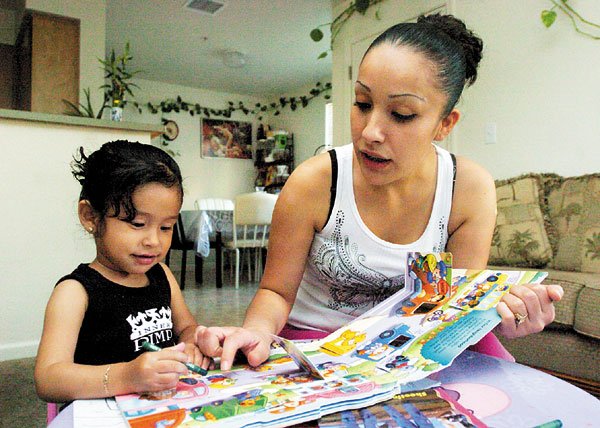Gilroy
– Ana Chavez, 19, cradles her 2-year-old girl between classes,
setting aside her backpack to lift the toddler onto her hip.
Gilroy – Ana Chavez, 19, cradles her 2-year-old girl between classes, setting aside her backpack to lift the toddler onto her hip.
“Girls tell me, ‘Ooh, I want a baby, she’s so cute,'” Chavez said, stopping by the childcare center across the parking lot from Mount Madonna High School. “They’re so dumb! Having a baby isn’t easy at all!”
Nearly three years ago, Chavez gave birth. Her friends disappeared. Her boyfriend split, jeering, “That’s what you get for opening your legs.” At home, she bickered with her mother; at school, she struggled to stay awake, after red-eyed nights rocking her daughter to sleep.
“She’s so precious to me,” Chavez said, “but I wish I could have waited longer.”
Her situation isn’t rare. Countywide, teen births have declined over the past decade, but South County remains a trouble spot for teen pregnancy. More than 6 percent of Gilroy teens gave birth in 2004, according to the county’s Public Health Department – a significantly higher rate than the 2004 California teen birth rate of 4 percent. Racial inequities riddle Santa Clara County’s teen birth rates: in 2003, the county’s Latina teens gave birth almost 18 times as often as white teens.
Teen pregnancy doesn’t just cost teens: In 2006, teen births cost taxpayers $42 million, according to the Public Health Institute’s Center for Research on Adolescent Health and Development. Teen mothers are less likely to finish school, more likely to experience pregnancy-related health problems and more likely to abuse their children, PHI has reported.
“Gilroy is a hotspot, unfortunately,” said Susie Law, coordinator of the Cal-SAFE Student and Family Education program, which served 106 teen parents or parents-to-be last school year. The same year, 34 Gilroy students in her program gave birth. And more are on the way: Today, of roughly 99 female El Portal Leadership Academy students, at least eight are pregnant, said MACSA program manager Gabi Mendoza.
Faith factors into teens’ choices
Law attributed Gilroy’s teen birthrate in part to the large Latina community, which is predominantly Catholic and shuns abortion. Many Gilroy teens who have premarital sex still consider themselves religious, citing their faith as the reason they didn’t abort.
“I did think about abortion, but just for a second,” said Geovanna Andoney, 17. Six months pregnant, she’s nearing graduation from El Portal Leadership Academy, and dreams of cosmetology school. “I’m against abortion. It’s not the baby’s fault.”
Most of the teens who stop into the South Valley Pregnancy Care Center, a Christian-based counseling center that provides free pregnancy testing, describe themselves as Christian, said director Nancy Corbridge. The vast majority are also Latina: from 2004 to 2006, the center served 301 Latina clients, compared to only 44 white clients and 28 of other ethnicities. SVPCC does not refer clients to abortion clinics, but Corbridge said the center’s counselors don’t tell teens what to do.
Despite their religious upbringing, boredom pushes some teens to be sexually active, especially low-income youth, said Gabi Mendoza, who runs the MACSA-Mujeres program at the Gilroy Youth Center. Every week, she leads discussion groups for teen girls, many of whom lack the funds for Gilroy’s teen entertainments: outlet shopping, movie theatres, even coffee shops.
“Gilroy’s small, and it’s boring,” Mendoza said. “These girls say, ‘I have sex because I’m bored.’ ”
Ignorance is another factor, said school district nurse Eileen Obata. Gilroy schools offer a few hours of sexual education in 5th and 6th grades, followed by reproductive anatomy and a one-day question-and-answer session on reproductive health and HIV/AIDS in 7th grade, said Obata, and a fourth, short program in 9th grade. In compliance with state law, Gilroy’s curriculum discusses abstinence, but also includes information about contraception.
Unfortunately, said Obata, the program still isn’t enough. Gilroy’s sex ed program is far shorter than 16-session and 20-session school programs recommended by the national safe-sex organization Advocates for Youth, which measures success by reduced teen pregnancies and sexually transmitted infections, and increased abstinence.
“You can’t go in two days and expect to change behavior,” Obata said, lamenting that years ago, the district ran out of funding for an after-school program about sexual health. “Since then, the pregnancies have been climbing.”
Programs aim to combat myths
Myths and misconceptions about sex persist among South County youth, said Law. Some teens think they can’t get pregnant the first time they have sex; others don’t understand how their bodies work.
“I have an 8th-grade student who didn’t even know what a uterus was – and she’d already had a baby,” Law said.
In addition, Law complains that some pro-life brochures over-emphasize the failings of condoms and other forms of birth control, and could dissuade teens from using them at all. Brochures available at the South Valley Pregnancy Care Center cite condom failure rates of 3.6 percent.
Planned Parenthood recently expanded its Teen Success support group program to Gilroy, concerned by a lack of accurate information among South County youth, said Julie Smith, an education program manager for Planned Parenthood Mar Monte. The program aims to maintain teen parents’ family size until graduation – and to get girls to graduate in the first place.
“In Hispanic culture, a lot of these topics aren’t discussed,” added Daniel J. Chavez, a neighborhood developer for South County Housing, which offers a five-part safe-sex workshop for teens and parents in its developments. The mobile program is currently in effect in Watsonville, and Chavez hopes to bring it to Gilroy.
Motherhood appeals to some teens
But teens such as Ana Chavez and Geovanna Andoney say they knew the risks of having sex beforehand, and both used condoms. Their pregnancies were unplanned, but not, it seems, entirely unwelcome. Chavez decided against abortion, she said, because she felt becoming a mother would push her to change her habits.
“I thought, ‘This baby can change my life,’ ” Chavez said. “If I keep living the life I’m living, I’ll just get pregnant again.”
Now, she said, she doesn’t drink, use drugs or party. Motherhood is tough – but it has also given her a sense of purpose, propelling her toward her goal of becoming a massage therapist. For some Gilroy teens, becoming a mother is an appealing prospect, especially among Latinas who value the family as “the core support unit, the mini-community,” said Mendoza.
One student, an 18-year-old girl who miscarried a few weeks ago, says she wants to be pregnant again, and as soon as possible.
“I see other babies, and I want my time to come already,” said the girl, speaking on condition of anonymity. Her voice trembled as she talked about her miscarriage; Andoney, a friend, burst into tears. “My family is Mexican and traditional, and they say I should wait until I’m married, until I go to college. But it’s something I want now.”
For Andoney, pregnancy is hardly ordinary – what with morning sickness, ultrasounds and a gradually growing belly – but being pregnant is finally OK.
“I’m not upset about it anymore,” Andoney said, wiping a mascara-black tear from her cheek. “It didn’t ruin my plans – but it changed them.”














